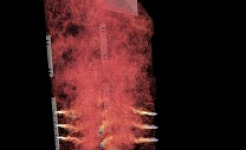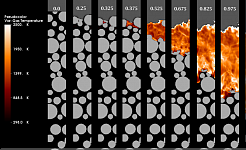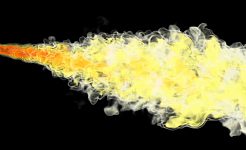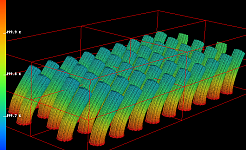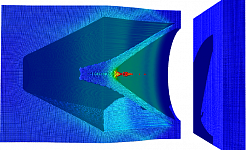Current Projects
The Carbon-Capture Multidisciplinary Simulation Center
The Carbon-Capture Multidisciplinary Simulation Center (CCMSC) is demonstrating exascale computing with V&V/UQ to more rapidly deploy a new technology for providing low cost, low emission electric power generation to meet the growing energy needs of the U.S. We are using a hierarchal validation approach to obtain simultaneous consistency between a set of selected experiments at different scales embodying the key physics components (large eddy simulations, multiphase flow, particle combustion…
Read more
Multiscale Multidisciplinary Modeling of Electronic Materials Collaborative Research Alliance
PI: Martin Berzins
Contract W119NF-12-2-0023 (04/16/2012 - 12/31/2016) US Army Research Laboratory
The purpose of the United States Army Research Laboratory (ARL) MultiScale multidisciplinary Modeling of Electronic materials (MSME) Collaborative Research Alliance (CRA) is to help fulfill the research and development goals of the U.S. Department of the Army. The Alliance brings together government, industrial, and academic institutions (University of Utah (Lead), Boston University, Rensselaer… Read more
Contract W119NF-12-2-0023 (04/16/2012 - 12/31/2016) US Army Research Laboratory
The purpose of the United States Army Research Laboratory (ARL) MultiScale multidisciplinary Modeling of Electronic materials (MSME) Collaborative Research Alliance (CRA) is to help fulfill the research and development goals of the U.S. Department of the Army. The Alliance brings together government, industrial, and academic institutions (University of Utah (Lead), Boston University, Rensselaer… Read more
Clean Energy from Fossil Fuels
PI: Phil Smith, Center for Clean Coal Technologies
The Arches component of the Uintah Computational Framework is being extended to model various energy technologies from traditional air-fired coal, oxy-fired coal/natural gas, fluidized bed coal combustion and coal gasification to more exotic coal technologies such as chemical looping and under ground thermal treatment. Additionally, Arches will be used to examine methods of flue-gas treatment for CCS and CO2 mineralization technologies. In… Read more
The Arches component of the Uintah Computational Framework is being extended to model various energy technologies from traditional air-fired coal, oxy-fired coal/natural gas, fluidized bed coal combustion and coal gasification to more exotic coal technologies such as chemical looping and under ground thermal treatment. Additionally, Arches will be used to examine methods of flue-gas treatment for CCS and CO2 mineralization technologies. In… Read more
Microscale Fluid Structure Interaction in the Slip Flow Regime
PI: Tim Ameel and Todd Harman
NSF award: CBET-0933574 (07/01/2009 - 06/30/2012)
Both rarefaction and fluid-structure-interaction (FSI) effects are significant for many microscale systems. Examples include micro valves, pumps, actuators, particulate flows, porous flows, two-phase flows, micro-air-vehicles, combustion, and heat exchangers. Rarefaction becomes significant for gaseous systems at the microscale and is typically quantified by the Knudsen number (ratio of the fluid mean free path to the… Read more
NSF award: CBET-0933574 (07/01/2009 - 06/30/2012)
Both rarefaction and fluid-structure-interaction (FSI) effects are significant for many microscale systems. Examples include micro valves, pumps, actuators, particulate flows, porous flows, two-phase flows, micro-air-vehicles, combustion, and heat exchangers. Rarefaction becomes significant for gaseous systems at the microscale and is typically quantified by the Knudsen number (ratio of the fluid mean free path to the… Read more
Petascale Simulation of Sympathetic Explosions
NSF OCI PetaApps award OCI 0905068
This project aims to advance the state-of-the-art in the computational modeling of hazards related to explosives through a combination of modeling, algorithmic and computer science developments. This advance will be achieved by performing simulations that have not been hitherto possible and so answering fundamental questions about ''sympathetic'' explosions in which the collective interactions of a large ensemble of explosives results in dramatically increased… Read more
This project aims to advance the state-of-the-art in the computational modeling of hazards related to explosives through a combination of modeling, algorithmic and computer science developments. This advance will be achieved by performing simulations that have not been hitherto possible and so answering fundamental questions about ''sympathetic'' explosions in which the collective interactions of a large ensemble of explosives results in dramatically increased… Read more
Hypervelocity Imapct of Granular Materials
PI: Jim Guilkey
Hypervelocity impact of granular materials, such as sandstone, is important to both defense and industrial applications. For example, in the oil industry small shaped charges are used to perforate through steel wellbore casing into reservoir rock to provide conduits through which to extract hydrocarbons.
This activity aimed to gain insight that is unavailable experimentally by carrying out meso-scale Uintah simulations of high speed impact of tungsten particles into a… Read more
Hypervelocity impact of granular materials, such as sandstone, is important to both defense and industrial applications. For example, in the oil industry small shaped charges are used to perforate through steel wellbore casing into reservoir rock to provide conduits through which to extract hydrocarbons.
This activity aimed to gain insight that is unavailable experimentally by carrying out meso-scale Uintah simulations of high speed impact of tungsten particles into a… Read more
Past Projects
Center for Simulation of Accidental Fires and Explosions - DOE
A DoE Advanced Simulation and Computing (ASC) Center
C-SAFE was officially decommissioned in November, 2010. However, there are a number of continuing projects built upon the C-SAFE legacy. These include the Uintah project, the University of Utah's Institute for Clean and Secure Energy's (ICSE) NNSA project, the Army Research Laboratory's Uintah-CRA, and the The Carbon-Capture Multidisciplinary Simulation Center (CCMSC).
The Center for the Simulation of Accidental Fires and Explosions, created… Read more
C-SAFE was officially decommissioned in November, 2010. However, there are a number of continuing projects built upon the C-SAFE legacy. These include the Uintah project, the University of Utah's Institute for Clean and Secure Energy's (ICSE) NNSA project, the Army Research Laboratory's Uintah-CRA, and the The Carbon-Capture Multidisciplinary Simulation Center (CCMSC).
The Center for the Simulation of Accidental Fires and Explosions, created… Read more
Penetration Survivable Advanced Energetics
PI: Scott Bardenhagen
The Unitah code was used to simulate energetic material formulations used in explosive penetrators or "bunker busters". It is well established that the heterogeneity of energetic materials at the mesoscale localizes deformation energy, generating "hot spots". It is imperative to understand the nature of hot spot spatial distributions, as their coalescence leads to sustainable reaction. Given the difficulties in determining hot spot distributions experimentally, this is an… Read more
The Unitah code was used to simulate energetic material formulations used in explosive penetrators or "bunker busters". It is well established that the heterogeneity of energetic materials at the mesoscale localizes deformation energy, generating "hot spots". It is imperative to understand the nature of hot spot spatial distributions, as their coalescence leads to sustainable reaction. Given the difficulties in determining hot spot distributions experimentally, this is an… Read more
Sensitivity Analysis
C-SAFE has under taken a sensitivy analysis of our fire/container simulations to study the effect of variations in a number of variables. These variables include 1) pool fire diameter (0.5 and 1.0 m firews), 2) wind speed (0 and 4 m/s), 3) container position relatvie to the fire (in or next to the fire), and 4) fuel evaporation rate (1.6 and 6.4 mm/min). Below are the visulations of serveral of these simulation. During the first part of the simulation, the averatge heat flux from the fire to…
Read more
Simulation Approach for Physical Systems Involving Multi-material Interaction Dynamics
Work within the duration of this award had two major components, improvements to the numerical properties of several of the Uintah components, and enabling the use of those components across a wider range of applications. In the former category, improvements to the Material Point Method (MPM) include better time integration, a more accurate method for transferring particle data to the computational domain and further AMR development. Uintah has been brought to bear on a number of new and…
Read more
Dense Polydisperse Polymer-Stabilized Colloidal Suspensions: Coordinated Rheology and Multiscale Modeling Studies - NSF GOALI
Colloidal suspensions consisting of micron and larger particles dispersed in a fluid medium, often water, are important for wide variety of technological applications. For example, aqueous-phase suspensions of colloidal particles are central to oil and gas production, comprising water-based drilling fluids, reservoir stimulation and fracturing fluids and fluids for reservoir conformance control. Additionally, good placement properties are important in the application of concrete, another…
Read more
Angiogenesis
PI: Jeff Weiss
The broad objective of this project is to study biomechanical interactions of angiogenic microvessels with the extracellular matrix (ECM) on the microscale level. This project is developing techniques to simulate the microscale biomechanical behavior of vascularized collagen gels using Uintah, using volumetric confocal images as the basis for generating the geometry of the computational domain [24] Figure 10. These segmented images will be automatically converted to a… Read more
The broad objective of this project is to study biomechanical interactions of angiogenic microvessels with the extracellular matrix (ECM) on the microscale level. This project is developing techniques to simulate the microscale biomechanical behavior of vascularized collagen gels using Uintah, using volumetric confocal images as the basis for generating the geometry of the computational domain [24] Figure 10. These segmented images will be automatically converted to a… Read more
Simulation of Foam Compression - DOE
Uintah has been used by collaborators at Los Alamos National Laboratory to model the dynamic compaction of foams, such as those used to isolate nuclear weapons components from shock loading. The Material Point Method component was used to carry out these simulations, which allowed for compression of the foam to full densification. This is noteworthy for several reasons. First, the geometry of the samples was collected using micro-CT. As in the angiogenesis project described above, because MPM…
Read more
Aerodynamic and Acoustic Models of Phonation - NIH
The Uintah fluid-structure interaction component, known as MPMICE, is currently being employed in a study of phonation, or the production of sound, in human vocal folds. This investigation has begun by determining the ability of Uintah to capture normal acoustical dynamics, including movement of the vocal fold tissue, and will consider pathological laryngeal conditions in the future. Uintah provides several important capabilities to this study. In addition to the ability to treat large…
Read more
Fabricated Microvascular Networks - NIH
Investigators at the University of Arizona have constructed a device akin to a three-dimensional printer for use in constructing engineered tissue samples to be used in implantation. One limitation to this approach is the incorporation of adequate vascularization in the engineered sample to ensure tissue viability. Uintah will be used to model the transport of oxygen and other tissue building blocks in order to optimize the design of the engineered specimens, allowing them to achieve…
Read more

